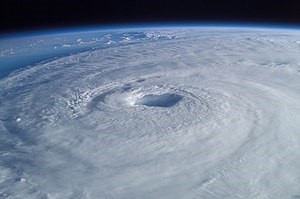
Image: Wikipedia
Picture of a hurricane taken from a satellite
How do airplanes fly in hurricanes?
Gabriel Joseph from Quora is looking for an answer to the above question.
I believe Gabriel is referring to commercial airliners rather than airplanes from ‘storm chasers’.
For commercial pilots, it would be madness to fly in hurricanes because such phenomena come with strong winds, heavy rain and severe turbulence. At best, they would deviate off route to avoid or divert to another airfield unaffected by hurricanes.
Hurricanes are basically strong tropical cyclones.
A Chinese or those from North Western Pacific will refer to these as typhoons, literally meaning ‘big wind’.
An Indian will describe such events as cyclones when they occur in the Indian Ocean, South Pacific or in South Atlantic.
An American will say they are hurricanes when they occur in the Atlantic Ocean or northeastern Pacific Ocean.
They are therefore known by different names at different locations but they are basically the same.
In the air, they inflict great discomfort to passengers. As such, airliners do not fly in hurricanes.
However, there are research planes that deliberately fly into hurricanes to gather data on their strength, position and structure.
An example would be the Lockheed Orion which is a highly instrumented aircraft made to endure large amount of thrashings.
Here is one of my memorable encounters with typhoon many years back in Shanghai (a narrative I have shared previously)
Some years back when I refused to take off on a Boeing 777 because of an approaching typhoon, an irate passenger mentioned indirectly that I was a ‘chicken’ and afraid to take off when another pilot flying a similar plane was able to depart.
This remark prompted the airport manager to persuade me to take off. I was, however, adamant and told him the prevailing cross wind was too strong for my take-off.
I explained this to the skeptical manager when he observed that the other aircraft parked beside us had left.
However, all that changed when we overheard from the control tower that a United Airlines Boeing 747 and a Virgin Atlantic Airbus A340 had been forced to return due to strong winds.
As such, our flight back to Kuala Lumpur was delayed until the typhoon had passed the next day.
The passengers who were initially very angry with us were soon very thankful when they met us after experiencing the rough ride on the bus back to the hotel.
Typhoons often cause disruptions to air traffic either because airports are closed or flights are cancelled. You may arrive home late but you may have also escaped a potentially dangerous situation.
The above pilot may have his reason to depart but each time we pilots signed in to fly an aircraft, we were dutybound to operate the plane as safely as possible.
The moral of the story: Airline pilots should not fly in hurricanes because, amongst others, commercial planes are not designed like the Lockheed Orion.
See video on How a Hurricane Is Born here
https://www.youtube.com/watch?v=4f45jA5UxB0